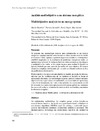Identificador persistente para citar o vincular este elemento:
https://accedacris.ulpgc.es/handle/10553/72273
| Campo DC | Valor | idioma |
|---|---|---|
| dc.contributor.author | Bastidas, Marlon | en_US |
| dc.contributor.author | Jaramillo, Patricia | en_US |
| dc.contributor.author | Chejne, Farid | en_US |
| dc.contributor.author | Galván González, Blas José | en_US |
| dc.date.accessioned | 2020-05-12T10:45:20Z | - |
| dc.date.available | 2020-05-12T10:45:20Z | - |
| dc.date.issued | 2010 | en_US |
| dc.identifier.issn | 0120-6230 | en_US |
| dc.identifier.other | WoS | - |
| dc.identifier.uri | https://accedacris.ulpgc.es/handle/10553/72273 | - |
| dc.description.abstract | An optimization methodology for complex energy system introducing external factors based on the newly developed Pareto-based multiobjective evolutionary algorithms (MOEA) used for solving a real-world power systems multiobjective nonlinear optimization problem is presented. The thermoeconomic, technology and environment objectives are included in this methodology and weights are assigned to each objective for evaluating the fitness and average sum. The complex energy system is integrated by a combined-cycle power plant (subsystem I) and a gasifier (subsystem II).The performance at weights of each objective is modeled by heuristic rules whereas the modification of decision variables is based on the application of random approaches. The methodology allows evaluating objective functions conformed by the fuel costs, the operation variable costs and maintenance costs. These are included in the capital investment equation. The goals in the optimization of this global system are to minimize product costs, minimize combustion residuals and maximize exergetic efficiency. | en_US |
| dc.description.abstract | Se presenta una metodología reciente para optimización de un sistema energético complejo introduciendo factores externos, basada en el desarrollo de fronteras Pareto –óptimas a partir de algoritmos evolutivos multiobjetivos (AEMO) empleados en la resolución de problemas energéticos reales de optimización no lineal. Se incluyen objetivos: termo-económico, tecnológico y ambiental, a los cuales se les asigna un peso para evaluar la función de aptitud, formada por una suma de promedios de cada objetivo. El sistema energético complejo está formado por un ciclo combinado (subsistema I) y un gasificador (subsistema II). El desempeño de los pesos en cada objetivo se modela por reglas heurísticas, mientras que las modificaciones de las variables de decisión se basan en aplicaciones aleatorias. La metodología expuesta, permite evaluar funciones objetivo formadas por costos del combustible, costos variables de operación y costos de mantenimiento, los cuales están incluidos en la ecuación de capital de inversión. Las metas en la optimización del sistema global son minimizar los costos del producto, minimizar los residuos de la combustión y maximizar la eficiencia exergética. | en_US |
| dc.language | spa | en_US |
| dc.relation.ispartof | Revista Facultad de Ingenieria Universidad de Antioquia (Medellín) | en_US |
| dc.source | Revista Facultad de Ingenieria Universidad de Antioquia [ISSN 0120-6230], n. 51, p. 44-51 | en_US |
| dc.subject | 120601 Construcción de algoritmos | en_US |
| dc.subject | 3322 Tecnología energética | en_US |
| dc.subject.other | Optimization | en_US |
| dc.subject.other | Multiobjective | en_US |
| dc.subject.other | Optimization | en_US |
| dc.subject.other | Thermoeconomic | en_US |
| dc.subject.other | Multiobjetivo | en_US |
| dc.subject.other | Optimización | en_US |
| dc.subject.other | Termoeconomía | en_US |
| dc.title | Análisis multiobjetivo a un sistema energético | en_US |
| dc.title.alternative | Multiobjective analysis to an energy system | en_US |
| dc.type | info:eu-repo/semantics/Article | en_US |
| dc.type | Article | en_US |
| dc.relation.conference | 3rd International Conference on Rational and Efficient Use of Energy | - |
| dc.identifier.scopus | 77952946909 | - |
| dc.identifier.isi | 000274458500006 | - |
| dc.contributor.authorscopusid | 27967522800 | - |
| dc.contributor.authorscopusid | 55814461100 | - |
| dc.contributor.authorscopusid | 6701630462 | - |
| dc.contributor.authorscopusid | 8704390300 | - |
| dc.identifier.eissn | 2422-2844 | - |
| dc.description.lastpage | 51 | en_US |
| dc.identifier.issue | 51 | - |
| dc.description.firstpage | 44 | en_US |
| dc.investigacion | Ingeniería y Arquitectura | en_US |
| dc.type2 | Artículo | en_US |
| dc.contributor.daisngid | 8159040 | - |
| dc.contributor.daisngid | 1866850 | - |
| dc.contributor.daisngid | 491379 | - |
| dc.contributor.daisngid | 1678121 | - |
| dc.description.numberofpages | 8 | en_US |
| dc.utils.revision | Sí | en_US |
| dc.contributor.wosstandard | WOS:Bastidas, M | - |
| dc.contributor.wosstandard | WOS:Jaramillo, P | - |
| dc.contributor.wosstandard | WOS:Chejne, F | - |
| dc.contributor.wosstandard | WOS:Galvan, B | - |
| dc.date.coverdate | Junio 2010 | en_US |
| dc.identifier.conferenceid | events120702 | - |
| dc.identifier.ulpgc | Sí | es |
| dc.description.jcr | 0,089 | |
| dc.description.jcrq | Q4 | |
| dc.description.esci | ESCI | |
| item.grantfulltext | open | - |
| item.fulltext | Con texto completo | - |
| crisitem.event.eventsstartdate | 13-11-2008 | - |
| crisitem.event.eventsenddate | 15-11-2008 | - |
| crisitem.author.dept | GIR SIANI: Computación Evolutiva y Aplicaciones | - |
| crisitem.author.dept | IU Sistemas Inteligentes y Aplicaciones Numéricas | - |
| crisitem.author.parentorg | IU Sistemas Inteligentes y Aplicaciones Numéricas | - |
| crisitem.author.fullName | Galván González, Blas José | - |
| Colección: | Artículos | |
Visitas
77
actualizado el 15-mar-2025
Descargas
30
actualizado el 15-mar-2025
Google ScholarTM
Verifica
Comparte
Exporta metadatos
Los elementos en ULPGC accedaCRIS están protegidos por derechos de autor con todos los derechos reservados, a menos que se indique lo contrario.
